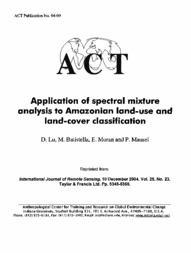Application of spectral mixture analysis to Amazonian land-use and land-cover classification.
Application of spectral mixture analysis to Amazonian land-use and land-cover classification.
Autoria: LU, D.; BATISTELLA, M.; MORAN, E.; MAUSEL, P.
Resumo: Abundant vegetation species and associated complex forest stand structures in moist tropical regions often create difficulties in accurately classifying land-use and land-cover (LULC) features. This paper examines the value of spectral mixture analysis (SMA) using Landsat Thematic Mapper (TM) data for improving LULC classification accuracy in a moist tropical area in Rondbnia, Brazil. Different routines, such as constrained and unconstrained least-squares solutions, different numbers of endmembers, and minimum noise fraction transformation, were examined while implementing the SMA approach. A maximum likelihood classifier was also used to classify fraction images into seven LULC classes: mature forest, intermediate secondary succession, initial secondary succession, pasture, agricultural land, water, and bare land. The results of this study indicate that reducing correlation between image bands and using four endmembers improve classification accuracy. The overall classification accuracy was 86.6% for the seven LULC classes using the best SMA processing routine, which represents very good results for such a' complex environment. The overall classification accuracy using a maximum likelihood approach was 81.4%. Another finding is that use of constrained or unconstrained solutions for unmixing the atmospherically corrected or raw Landsat TM images does not have significant influence on LULC classification performances when image endmembers are used in a SMA approach.
Ano de publicação: 2004
Tipo de publicação: Artigo de periódico
Unidade: Embrapa Territorial
Palavras-chave: Landsat Thematic Mapper, Vegetation species
Observações
1 - Por padrão são exibidas publicações dos últimos 20 anos. Para encontrar publicações mais antigas, configure o filtro ano de publicação, colocando o ano a partir do qual você deseja encontrar publicações. O filtro está na coluna da esquerda na busca acima.
2 - Para ler algumas publicações da Embrapa (apenas as que estão em formato ePub), é necessário ter, no celular ou computador, um desses softwares gratuitos. Sistemas Android: Google Play Livros; IOS: iBooks; Windows e Linux: software Calibre.
Acesse outras publicações
Acesse a Base de Dados da Pesquisa Agropecuária (BDPA) para consultar o acervo completo das bibliotecas da Embrapa.

